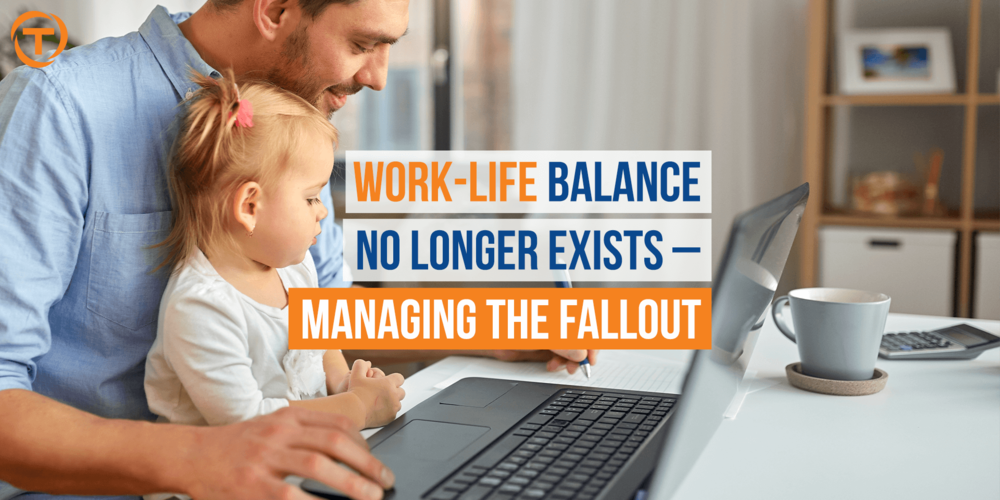Walking away from work at the end of a day when increasingly more workplaces are at home at least part of the time, is no longer an option - with less of the physical separation that once existed. Even for those who spend most of their time on-site; colleagues, clients, and customers may be working from home, which means their blurred boundaries will eventually cross over into yours.
While our workplaces have changed since Covid, we are still chasing that elusive work-life balance which was hard enough to achieve when we had the physical separation between work and home. With our new ways of working, the latest advice is to create a dedicated space in your home for work, set boundaries with your workplace about your hours of work and find ways to switch off at the end of the day. If we couldn't achieve work-life balance before, locking the study door at the end of the day isn't going to work.
We need to accept that work-life balance is an outdated concept and what we need to aim for, is work-life harmony.
Tip #1 – Shift your mindset
Start by discarding the long-standing belief that work-life balance is the golden ticket to happiness. No matter how hard you try, just because you've clocked off doesn't mean you're free from work. You may still have to respond to a call, review your schedule or finish an urgent/overdue task. As a manager or company leader, you will likely need to think about work even when you're not physically attending to your duties.
However, this doesn't mean that work-life harmony is unachievable. If you're smart about it, it can work in your favour. When we stop trying so hard to create the perfect balance, we reduce the stress levels associated with trying to achieve the impossible and find we are freer and happier as a result.
Tip #2 – Love what you do
In the past, work-life balance meant leaving work hours behind to make time for hobbies, but why can't you treat your work/career with the same mindset as a hobby or past time? Doing so makes it more palatable when "work" interrupts us and isn't treated with the same negative emotions as we try and find balance. While work is a necessity to pay the bills, nothing is stopping us from doing work we love. Whether it be the job itself, the people we work with, or the outcomes we achieve, what constitutes work you love is different for each of us.
Like our hobbies, there are elements of work we may not love but are a necessity. After all, most artists don't love washing their brushes - however, the vast majority of your work should ignite your passion. Best of all, when we love what we do, it is easy to get into the zone, be motivated and ultimately excel.
If you don't love what you do, there are options. In this day and age, you have access to a career counsellor, business coach or mentor who can help evaluate your options. You can speak with your local TAFE or University about courses that may be suitable or spend some time with a recruitment consultant who can give you guidance on how your skills could be transferable in a role that lights your fire.
Tip #3 – Create non-negotiables around what matters
Work-life harmony is about making time for all aspects of life that fulfil us. One way to start is to determine your non-negotiables - those things you choose to make a priority. It may be breakfast with the family, a daily gym session, a morning meditation, walk with the dog, lunch outside or downtime on the couch of an evening – it could even be aspects of your work. Everyone’s life-stage, needs, values and non-negotiables are different.
The challenge here is making them a priority – often these elements can be compromised with little effect in the short-term so they can slip down the list. However, the cumulative effect of missing these things can make a significant impact on your life. If you think about the impact a health or relationship issue can have, it can be devastating – which is what makes work-life harmony so important.
For some, scheduling non-negotiables into the diary works best, for others making commitments outside the house such as meeting a personal trainer, friend or family member makes it harder to break. For others, it can involve flexibility – if work gets in the way of the morning gym session, move it to the afternoon rather than skipping it altogether. For others, turning off phones and tech for intervals of time may be a necessity.
It's a good idea to schedule some time each week to reflect on your non-negotiables, whether you were successful and what changes you will make in the weeks ahead to ensure you meet them.
Tip #4 – Work when it works, don’t when it doesn’t
If you have the luxury of choosing your hours, then consider what makes your perfect day. Are you an early riser who likes to smash out emails in the mornings? Are you a night owl who wants to work when everyone else is quiet. Work-life harmony is about working with our body's natural rhythm's.
Working around your productivity peaks can boost efficiency and effectiveness. You'll find you get more done in less time, freeing up time to do other things. The challenge is that everyone has different productivity peaks, so how can you work together if everyone is "on" at different times?
Global companies have managed this challenge for decades with their varying time zones and have found communication and planning to be critical. Most teams find it useful to have a schedule or routine so that everyone knows who is working when and plans tasks within those times. The secret to making this approach successful is respecting these availabilities – just because you are working on a report at 2am doesn't mean it is ok to start firing off texts and emails expecting immediate responses. Instead, plan to get what you need prior.
For office-based jobs, there are online tools share when you are online, available, in meetings or in do not disturb mode; which can be useful for knowing when to reach out to colleagues.
For site-based jobs, ask your team members the times that suit them best and provide them with flexible options. Some people prefer to take the morning shift, while others prefer afternoons or evenings. While this is the norm for many industries, those that are new to this way of thinking could use it as an opportunity to extend operating hours and service the needs of customers and clients quicker than ever before.
Tip #5 – create red rope boundaries
Setting boundaries has been a work-life balance concept for many years and one of the most difficult to manage in reality. "Brick wall" boundaries that cannot move, no matter the circumstance, often do more harm than good. For example, committing to turn off the phone after 6pm to ensure you are present with the family, doesn't work if you spend the whole time worrying about the consequences of not being contactable.
Creating what we call "red rope" boundaries can be more effective. Like the red ropes used outside an exclusive event, they keep the traffic moving in the right direction but bend and flex a little as needed while still getting you to the desired destination.
We have become accustomed to frequent emails and text messages which puts the pressure on us to check our phones and be tempted by non-urgent tasks. Asking your boss, team or clients to call when things are urgent means you don't have to keep checking your messages, allowing you to be more present instead of worrying about what is happening in your absence. And, taking the odd phone call when on a date, out with friends or family is far less intrusive than someone tapping away at emails the entire dinner.
Tip #6 - Prevent burnout
In 90% of cases your work to-do list will never be completed because as you complete one task it leads to another. Add the pressure to be the perfect mum, dad, brother, sister, friend who gets 8 hours sleep, works out daily, looks after their mental health, eats healthy home-cooked meals, has a clean house, travels, has several hobbies and more…is enough to make anyone's head spin.
The age-old saying of 'something has to give' still applies, and it is ok to give certain things up while pursuing your career goals and personal dreams. The sooner this is realised, the faster you'll be able to cut out the unnecessary until you've reached your goal. And with the mindset shift to work-life harmony - you are in control of what gives.
Summary
Stop trying - discarding the belief that work-life balance is the golden ticket to happiness.
Love what you do, so when work encroaches on to other parts of your life, it is more palatable.
Prioritise your time according to your values, stop focusing on evenly compartmentalising your time
Determine what works for you and work around your productivity peaks.
Respect others and their ways of working.
Be flexible when creating boundaries so that they work for you, not against you.
Prevent burnout by recognising something has to give and making it a conscious choice.
If you need assistance with hiring, contact a recruitment agency like Trojan Recruitment Group and receive advice from the experts in labour-hire, permanent and contract staff.
Sources
https://www.entrepreneur.com/article/334723
https://www.business.com/articles/work-life-boundaries/


